AI+
How AI is finding its way onchain.
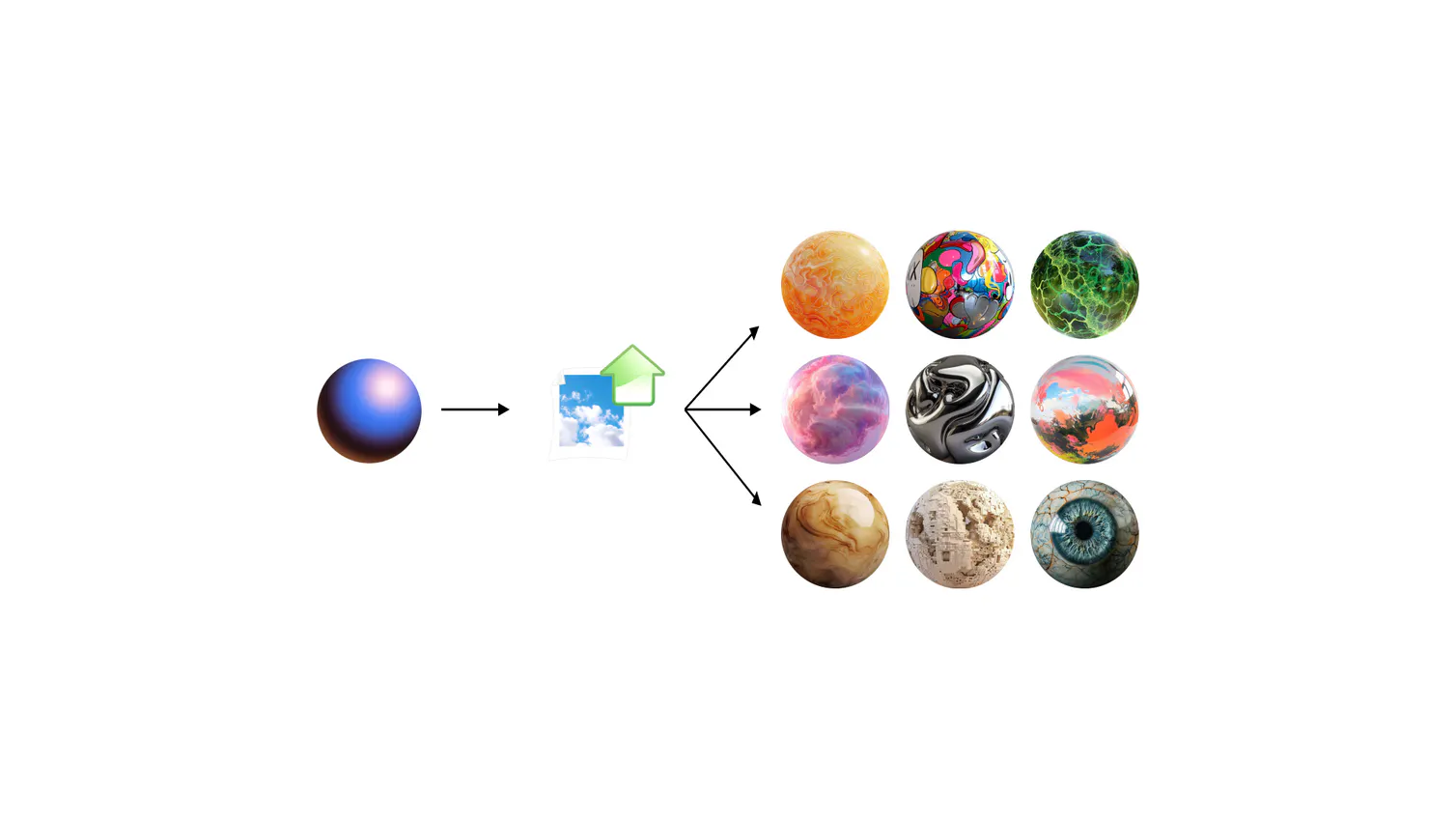
Over the course of a weekend in late 2018, I minted some AI generated artworks on Superrare. Earlier in the year I had my first big aha moment on NFTs, and I was a huge fan of all of the work that Robbie Barrat had created. I noticed they’d open sourced their tools to train and run models. I figured it would be interesting to combine the outputs of a social network with a neural one. So I downloaded the top posts of all time from the EarthPorn subreddit, trained a model on my MacBook Air (lol), and then minted my favorite ones.
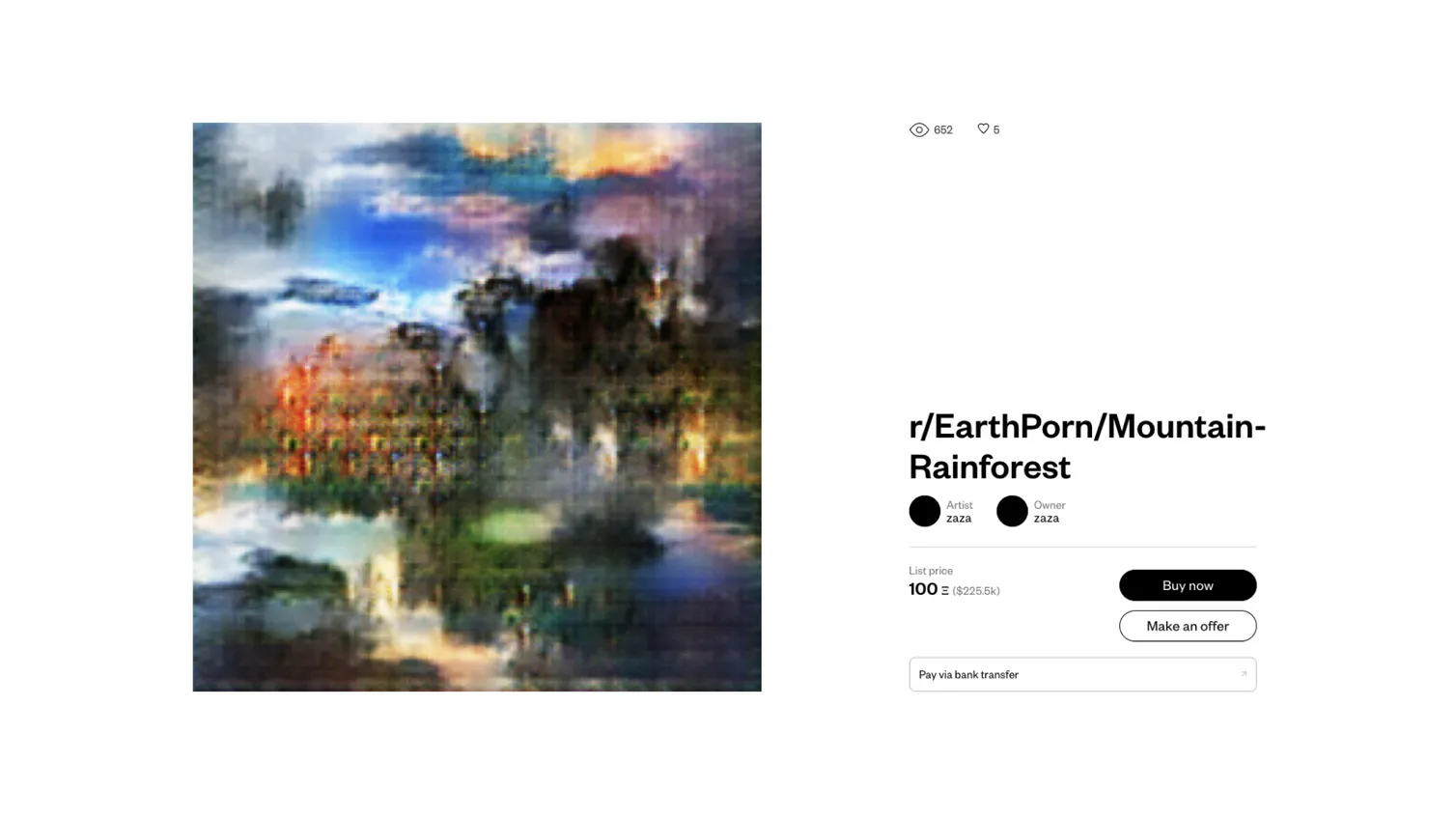
Minted on Superrare (2018)
The lack of computing power shows, but it was fun to go end to end from training to minting onchain. Funnily enough, that profile on Superrare was originally named Zora. I later renamed it to Zaza when I left Coinbase to start Zora as a full time project. Both AI and crypto have come a long way in the six years since—but it is still early.
Crypto and AI are two complementary technologies:
- Crypto: you can mint a piece of information, making it available to the entire internet. Minting this piece of information means that it can be bought, sold, transferred, and managed as an asset. This means it can be valued and verified.
- AI: you can create a model that is trained on information, making it remixable and accessible to the entire internet. Training a model on it means that this information can be interpreted, remixed, represented, articulated and synthesized as knowledge. This means that it can be utilized.
Simply put:
- Crypto wants information to be onchain so that it can be valued and add value to the system.
- AI wants information to be onchain so that it can be freely accessed and utilized by the system.
This isn’t particularly new, but it isn’t particularly obvious either. There have been a long list of experiments and historical clues that point towards this version of the future.
Here is a non-exhaustive and intentionally short list of examples:
- Robbie Barrat: the first ever mints on Superrare, were AI artworks.
- Botto: a community driven AI artist
- Holly+: the first model to be minted onchain, with onchain economics for derivatives
- Opepen: AI derivatives of the core symbol are synonymous with virality of the project
- Titles: a custom model created for Zorbs + a tool to remix with splits built in
- Readyweights: a symbol with a model encoded within it to remix the symbol
- A substantial number of things minted onchain involve AI output
The above list is quite biased, because from three onwards, they are all on Zora—utilizing our network, our symbol, our protocol, or our tool in one way or another.
At a very high level, every project has the following core components: training data, a model, a tool, its output, and prompts. I’ve outlined each of them in detail below.
Training data
The set of information that the model is trained on. The more high quality training data you have, the more productive and useful the resulting model is able to be. To date, the most successful models have scraped the entire internet, often without permission, to train their models.
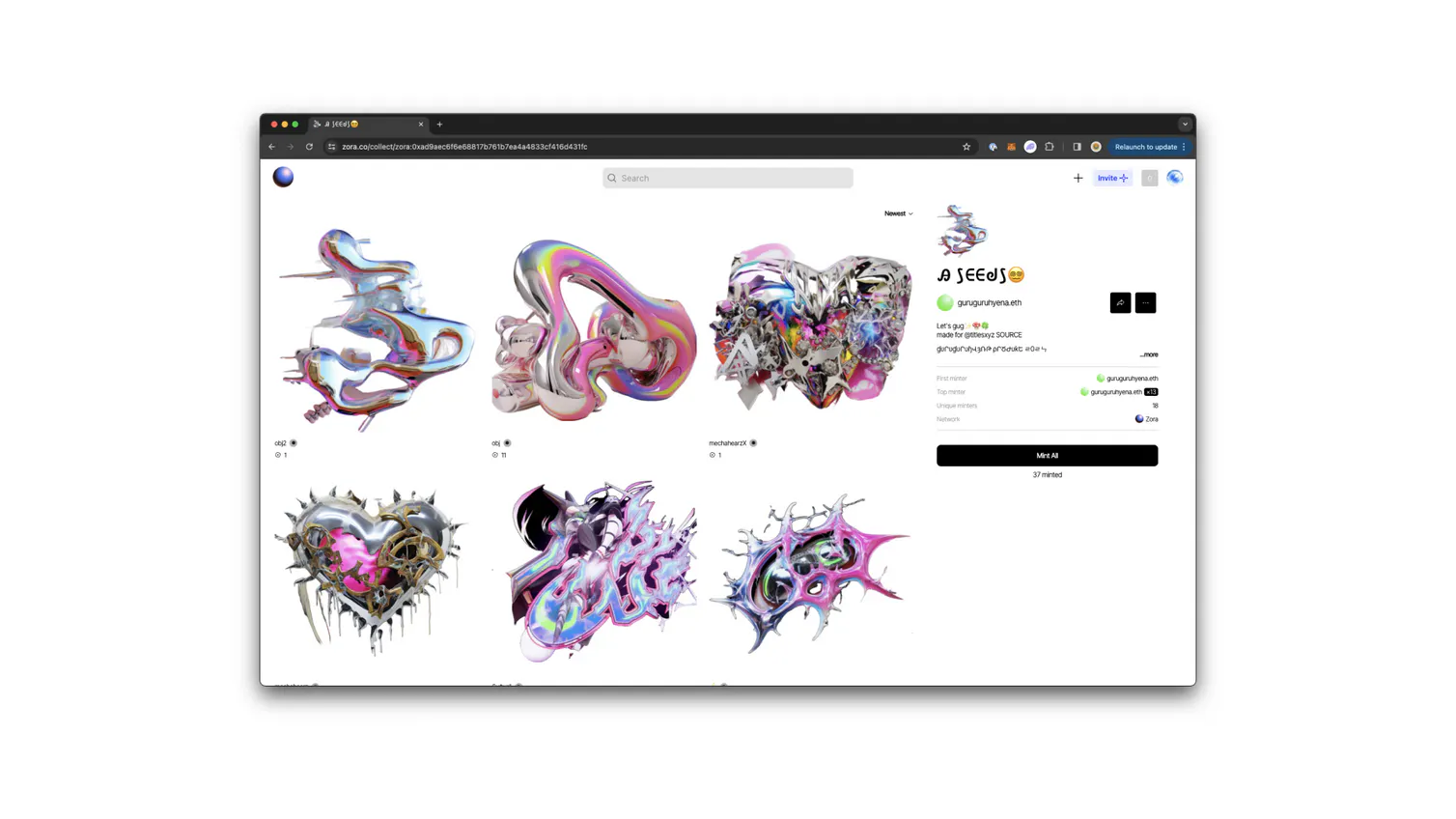
A collection by guruguruhyena purposely minted to be trained on for a Titles AI model (2024).
There are already hundreds of thousands of unique pieces of media onchain. Instead of having to scrape webpages and skirt their terms of service, you can easily access and traverse them by smart contract addresses to get the files on IPFS, and in some cases directly onchain.
By minting things onchain, the creators of that information have a built in attribution and value system, while making it all available to the public and available to be trained. Fred Wilson recently put forward this exact idea in the context of minting.
Models
These are the breakthrough programs that can produce things based on the training data. Between ChatGPT, DALL·E, Midjourney, and Stable Diffusion to name a few—we now have incredibly powerful new ways to create with.
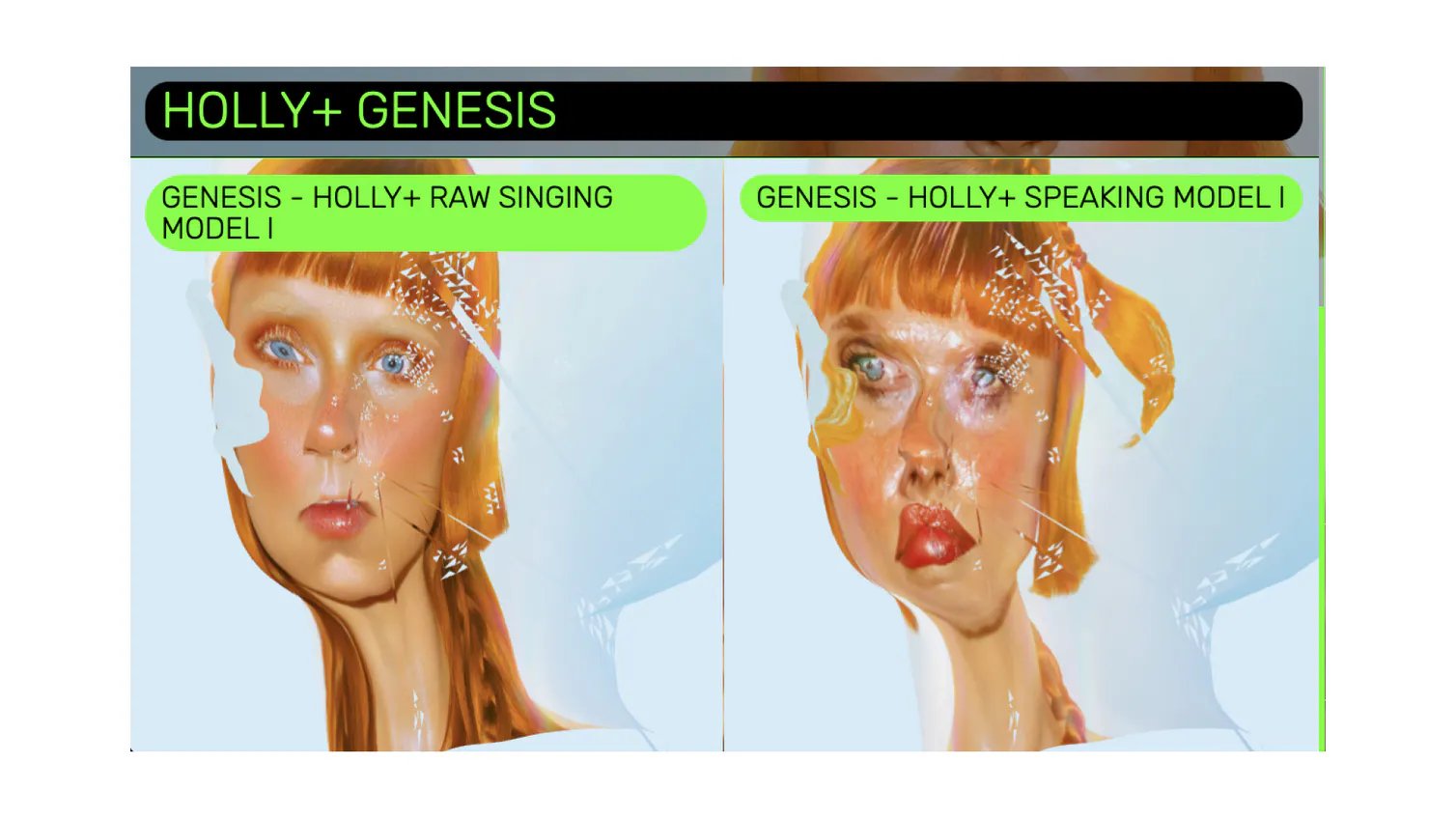
Holly Herndon’s singing and speaking models. Minted (2022).
There have already been experiments in bringing these models onchain. For example, Holly Herndon’s raw singing model minted on Zora and auctioned for 15 ETH in 2022. Anyone can use this model to essentially use Holly’s voice as an instrument to sing in their music.
Training models require substantial amounts of computing power, which costs a lot of money. There is a bustling category of startups that are looking to bring this exchange of money for computing power onchain too.
Tools
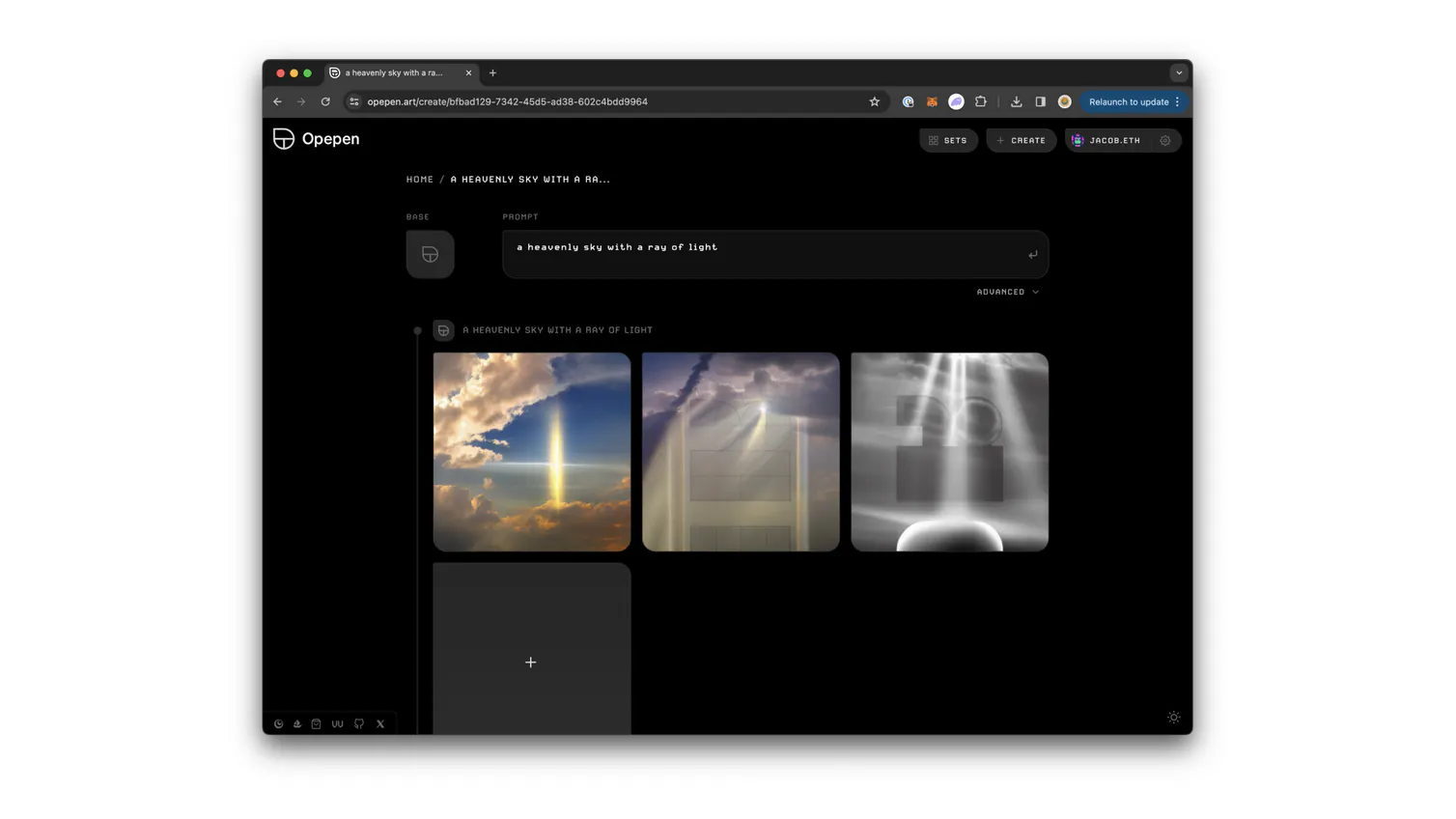
Opepen.art makes it easy to create remixes with the core Opepen Symbol
The interfaces that make it easy to create with the model. E.g. Midjourney, DALL·E, Opepen, Runway. These make it as easy as typing a prompt to create images, videos, and audio—massively reducing the barrier to entry to create.
Right now, these tools are more often than not tightly coupled to models that are closed source. Stable Diffusion is an open source example that has an increasingly vibrant community of developers and tools built on top of it. These models are extremely valuable to society when made public, perhaps bringing them onchain can also make it a valuable endeavor for the creators of them. One idea could be for these tools to make it easy for people to mint their output, and include the models in a split for sharing the earnings.
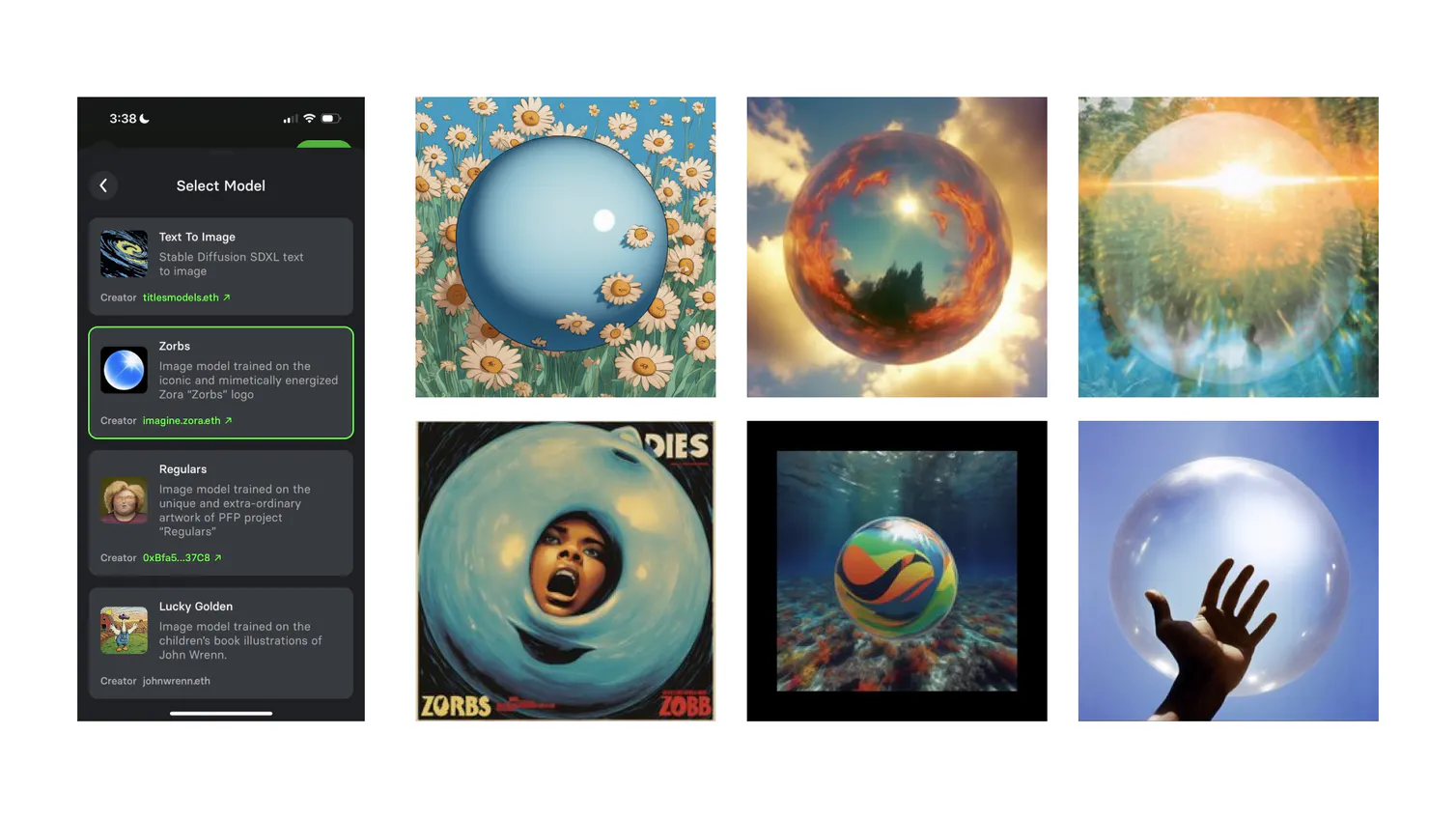
The Zorb model in Titles with Zorb artworks that were minted (2023).
In fact, this idea is being put into practice by Titles, which helps train models for creators, integrates it into a creator tool, and then shares splits with the creator. Zora worked with Titles on an onchain Referencing standard that makes it easy to attribute and pay back to the model creators. The model and all of the derivatives are minted on Zora Network.
Output
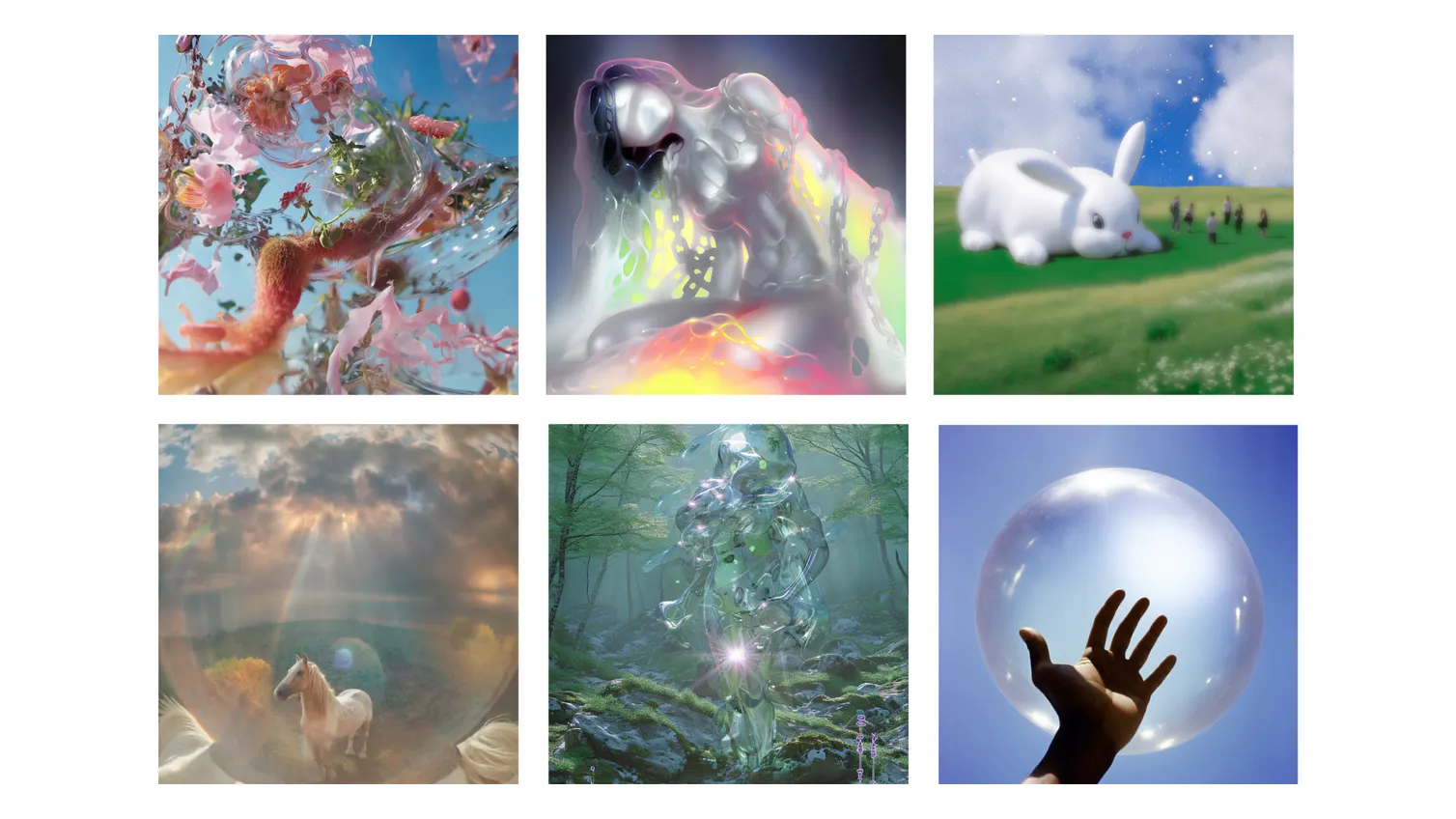
All of these have been in part created with AI and are minted on Zora
The things that the model produces. These can be text, images, videos, sounds, anything really. To date, this has been the most minted aspect of AI works to date.
There are thousands of unique pieces of art, media, and content that have been minted and collected. In some cases, they are highly valued too. Robbie Barrat’s works from 2018 routinely sell for hundreds of thousands of dollars.
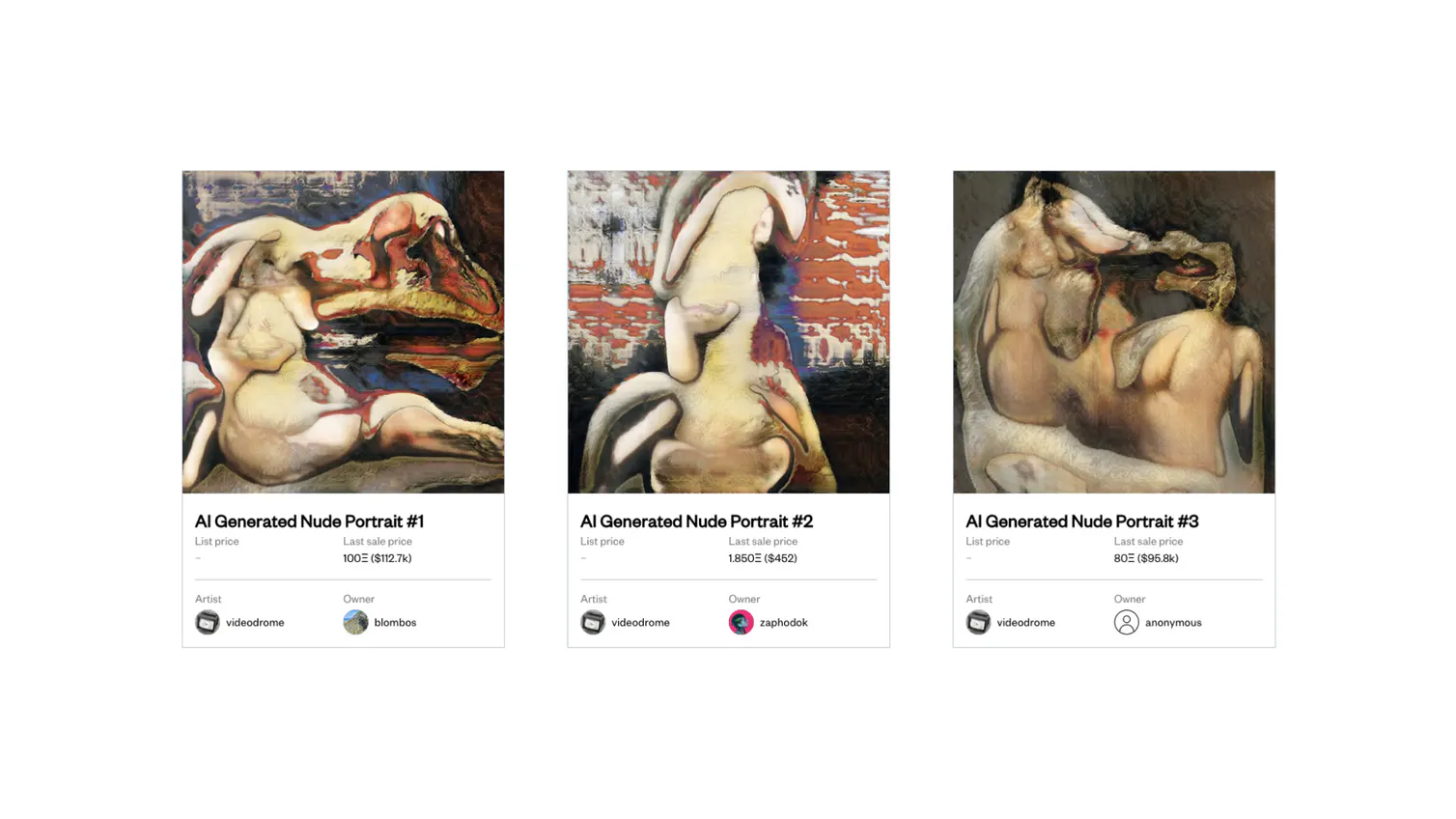
The first three AI Generated Nudes by Robbie Barrat (2018)
The fact that the final output of AI is valuable likely means that the other components are too. Interestingly, this could inform what might be useful to train on next. Developers can start to use the market value of the information as a weighting in training. While this is currently being applied to art and media. As we see things like ideas and predictions in the form of Notes increasingly coming onchain, perhaps more factual forms of information start to be trained on based on their value.
“In this new paradigm, crypto uniquely empowers you to own your public or open source IP. When you mint your media, you create provenance and preserve your optionality to monetize the work as you see fit. Pure ownership in an open IP paradigm with the click of a button. The mint button.”
— Dee Goens, Mintellectual Property
The value of these works are a function of their provenance: i.e. who it came from, the moment in time, and the work itself. By nature of minting, all of this information is publicly and freely accessible. Increasingly crypto is an internet native IP system in so much as it is an internet native financial system. Minting offers a solution to some of the attribution and value capture problems that AI is revealing in the traditional system.
Prompts

A prompt and its Midjourney output. Both minted (2023).
The text input given to an AI model to generate a specific response or output. Quality and imaginative prompts tend to lead to quality and imaginative output. It is as much art as it is science. There is essentially an entire practice called “Prompt Engineering” where people are designing and refining inputs to get the best responses from AI models.
Nick St Pierre is a great example of someone who actively educates people on how to get the most out of MidJourney with specialized prompts.
Prompt space is something that you could imagine gets established and competed for onchain. Having your symbol, logo, artist signature, tone of voice or aesthetic being captured in widely used prompts, or new prompts, can be a new way to distribute and expand the notability and recognition of it.
For example, Apple would want to be sure that if someone types “Computer” or “Phone” that the output is closer to a Macbook or iPhone than a PC or Samsung. This will be true for any symbol. This is not too dissimilar to competing for keywords in Google, and putting in a lot of work to SEO and potentially, a lot of money into ads for ranking.
In the case where we see:
- An increasing amount of media onchain
- An increasing amount of models being trained on that media
- Market value as a new weighting in training
You can imagine that minting your media and IP generally is not only a way to establish ownership and capture value from mints, but is also increasingly important to establish its position within prompt space.
Putting it all together
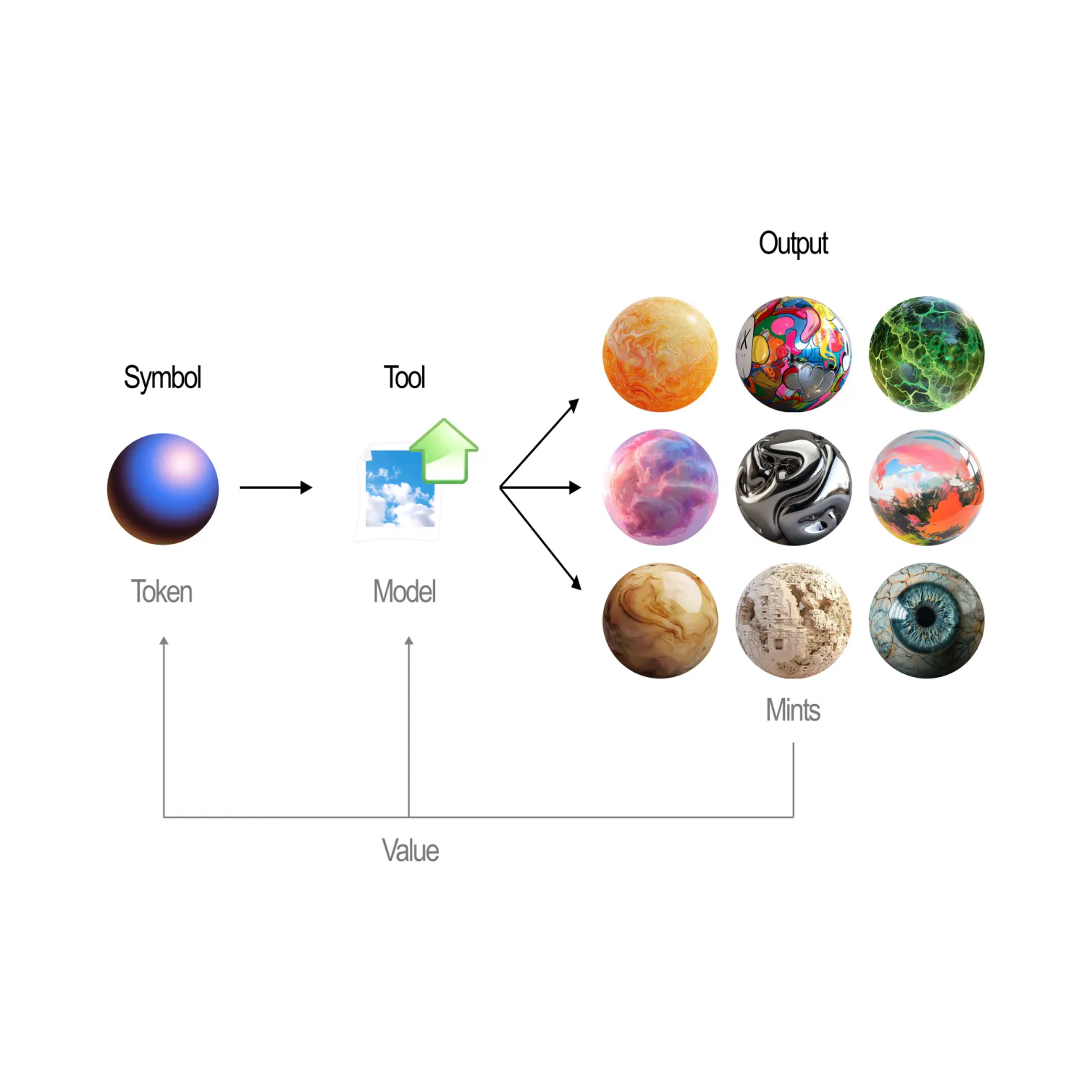
In the prevailing version of the internet, AI is directly at odds with the existing business models of most creators, platforms and IP holders. This is in large part due to the IP and copyright system that the internet is currently built on, which monetizes by restricting access by ad wall or paywall.
Its very clearly not working in its current form. The creators of Midjourney have completely given up on attribution, since there’s no way to do this programmatically on the current internet. The NYTimes is suing ChatGPT for billions of dollars for training their models on over 100 years of journalism. Twitter and many other platforms have further locked down their APIs to stop training. The incentives of the current system are playing out.
Crypto is a new IP system in the same way that it’s a new financial system. That is, very early, high potential and unlocks net new use cases and solutions to problems that it can uniquely serve. With AI, crypto as an IP system is a solution to the existential challenges it unearths in the current internet. Crypto wants and rewards information to be onchain so that it can be valued and add value to the system. AI wants information to be onchain so that it can be freely accessed and utilized by the system. AI is a fundamental breakthrough technology, and with that comes disruption of incumbent systems. However, when paired with crypto that disruption can very well be a massively positive unlock in value capture for a lot of the entities it is disrupting.
What’s starting with art and media onchain, is leading to an internet that can honor the value and attribution of the creation of new knowledge while making it remixable and accessible to use in AI tools. All which will bring even more new work and knowledge onchain, accelerating the flywheel.
It’s only just getting started, and it’s only going to get weirder.
Some further thoughts and questions
Projects like Botto are showing that you can use token governance to vote on which AI works should be minted and sold. Opepen has an open submissions model that is also token votable. Perhaps there is room for creator tools that close the loop by making it possible for communities to vote on what goes into a model in the first place.
- What would the Ethereum, Solana or Bitcoin models look like today? Where you train models based on all available NFTs that have been minted to date. How distinct or similar would the aesthetics of each model be? I’d imagine something quite different.
- Assume you minted every possible point of latent space for a model. Which points would be the most valuable and why? How valuable are the prompts (or inputs generally) that lead to that output?
- Assume every single address minted the exact same AI output and the exact same time, which one would be the most valuable and why? What does that reveal about how this value system works?
- To what extent can models actually run onchain? Minting them is a step forward on attribution and at least one form of value capture, but how can we make running and using them onchain possible?
- Agents with capital. It’s not particularly easy for AI systems to get access to a bank account or brokerage account. To some extent we actually see this in traditional markets with hedge funds and market makers using machine learning to trade. What does it look like for AI agents to have an ETH balance and be able to freely interact with the entirety of the onchain economy? What are the ways to keep this safe?
- Assume a situation where every piece of information has an onchain market value, how might those values positively or negatively impact the training quality of models? More generally, how might that generally impact the perception and searchability of information at large?
- Symbols (f.k.a. logos) have always been incredibly important and valuable in establishing a brand. In the context of AI and onchain economics, they may be even more important and valuable. Remixability is crucial, and being recognizable in a wide range of circumstances and aesthetic concepts. The best symbols can become widespread memes by building AI based tools that make it easy to remix and share. Zorbs and Opepen are great examples of this. We’ll likely see Dogecoin level (>$B) returns with this specific flywheel at play.
Zora is the onchain home for AI
Each of the examples and projects above are an exciting window into the future of what’s possible when you bring AI onchain. Over the past few months, Zora has become the home for media and content onchain, making it increasingly ripe for builders to push the boundaries of the types of tools and infrastructure that can be built.
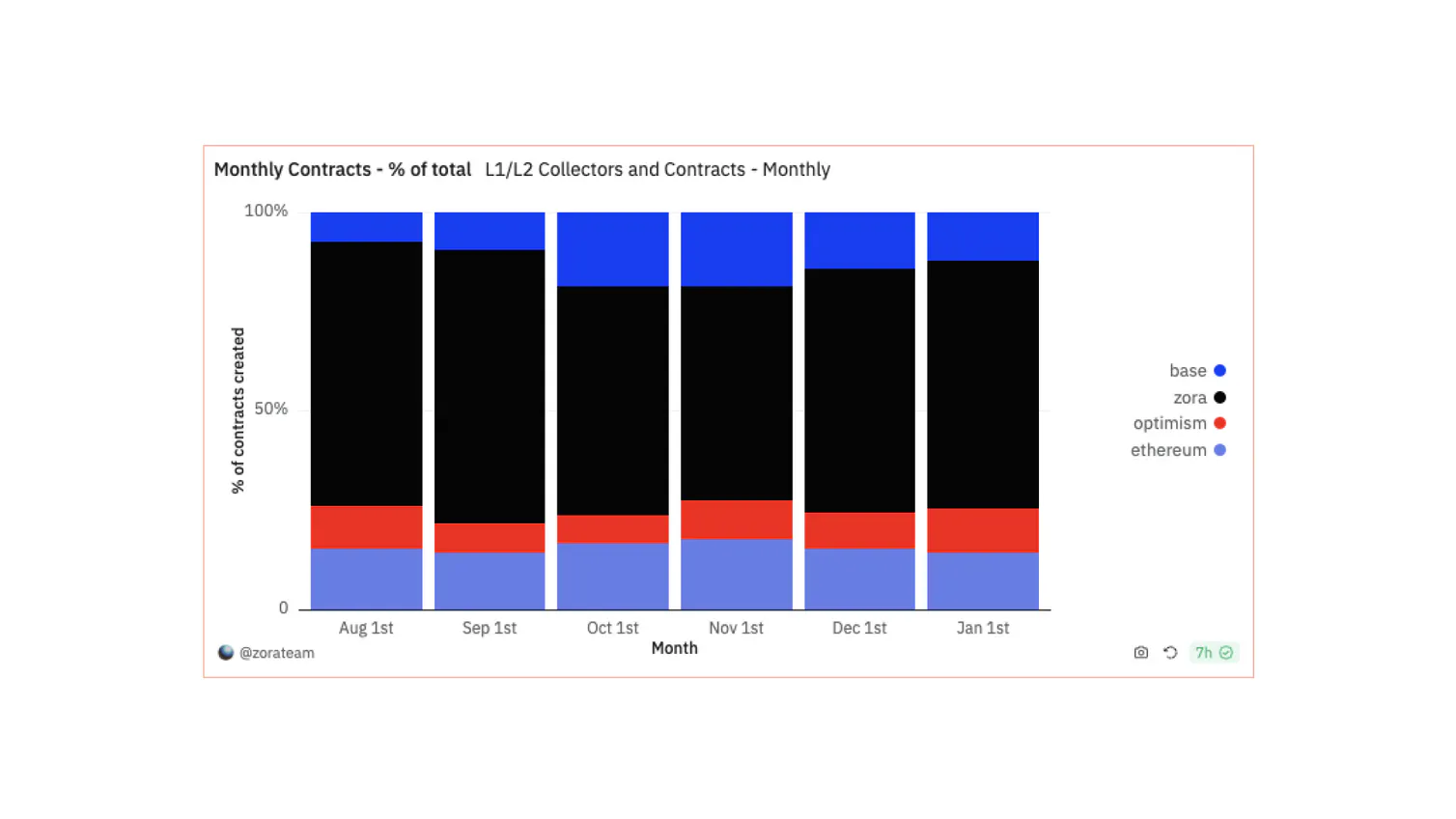
Zora Network sees the most amount of unique contracts deployed across EVM networks
We’re only scratching the surface of what’s possible. We will continue to support the ever increasing number of creators and developers that are pushing this frontier forward, and are excited to extend our protocol and platform into unlocking the possibilities of bringing these two technologies together onchain.
We want to collaborate and work with more partners—if you’re building or creating on the forefront of AI, please reach out! Zora is the home for AI onchain.
